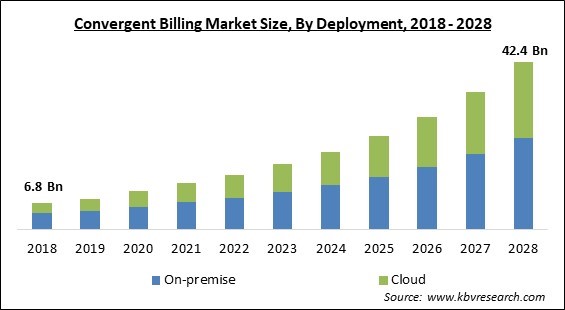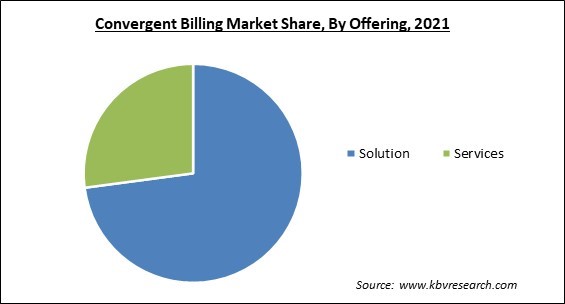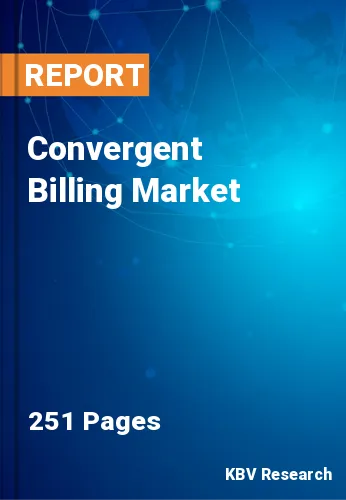The Global Convergent Billing Market size is expected to reach $42.4 billion by 2028, rising at a market growth of 20.5% CAGR during the forecast period.
Convergent billing is the consolidation of all service fees onto a single customer invoice and the creation of a unified customer profile. Customers can contact a call center to receive complete account details and information for all the services they have subscribed to. For all services, the customers will receive a single bill and would pay a single payment.

A convergent billing platform is a finance and revenue management platform that the telecommunications sector uses to consolidate all service charges into a single consumer bill. The consolidated statement provides consumers with a comprehensive perspective of all the services they have purchased. The expansion of the industry can be attributed to the lower cost of billing processes, multiservice packaging, improved customer experience, and pricing that enables clients to purchase services at a discount, and centralized customer assistance.
Support for multiple service types, such as voice, data, multimedia, and content, support for service bundling, and the capability to generate a single bill or statement for all communications services including mobile, fixed, broadband, and TV are characteristics of a convergent charging and billing system. A convergent billing system is described as being able to control services and monitor account balances in real time.
This includes authenticating the subscriber as well as verifying the account balance prior to delivering the service to the end user. A converged billing system can additionally warn users when the account balance threshold defined by the operator has been reached or stop service connectivity when real-time billing indicates credit has been depleted. This real-time feature can be utilized to offer promotions and alerts to service users in an effort to increase usage.
In recent years, the majority of sectors around the world have suffered unfavorable effects. This is attributed to major disruptions in their respective industrial and supply-chain operations caused by various precautionary lockdowns and other limitations imposed by governing agencies all over the world. In addition, consumer demand has subsequently decreased as consumers have become keener on removing non-essential expenses from their various budgets as a result of the severe economic impact of the outbreak on the majority of people. These factors are anticipated to exert pressure on the Convergent Billing market's revenue growth in the coming years. However, as individual governmental agencies continue to relax these restrictions, the convergent billing market is anticipated to recover proportionally.
The telecom business is undergoing rapid evolution, and its requirements are rising quickly. In the present state of affairs, convergent billing has evolved as the optimal approach for meeting the newly established requirements. Convergent billing is the first step toward new heights for all telecommunications companies aspiring to provide world-class services. It ensures that businesses augment cutting-edge convergent billing services and solutions with APIs by collaborating with a provider that develops them for a variety of business use cases.
The greatest advantage of switching to a convergent billing platform is the increased ease with which additional services can be added. Regardless of whether it is OTT (Over-the-Top), IoT (Internet of Things), or something else entirely new, convergent billing performed via an OCS performs far better than older IN or offline charge systems. A modern system that provides convergent billing is also more adaptable than these legacy systems.
Multiple transmission platforms are required to provide a comprehensive collection of bundled services. Voice has typically been routed through voice switches, such as DMS-250s and Class 5 switches, while data has been routed via routers. So, invoicing has always been challenging; producing a single invoice, etc. But if voice and data become packetized or run-on optical switches and everything else, then they are essentially running on a single platform and would be managed by a single billing system.
By Offering, the Convergent Billing Market is divided into Solutions and Services. In 2021, the services segment registered a substantial revenue share of the convergent billing market. The rapid surge in the growth of this segment of the market is majorly owing to the higher accuracy and precision of services that are being offered by several prominent market players operating in the industry throughout the world. In order to maximize their revenues, telecom businesses are increasingly investing in professional convergent billing services. Hence, this factor is fueling the growth of this segment of the market.

Under Solution Type Outlook, the Convergent Billing Market is divided into Customer Relationship Management, Settlement & Payment Management, Mediation, Voucher Management, Others. In the solutions type segment, the Customer Relationship Management segment acquired the largest revenue share of the convergent billing market. CRM encompasses the organization's core principles for customer interactions. It includes sales and service-related operations, forecasting, and analysis of consumer behavior. CRM solutions may provide customer service, segmented product offerings, and complex discount methods.
By Deployment Mode, the Convergent Billing Market is bifurcated into Cloud and On-premises. In 2021, the on-premises segment witnessed the biggest revenue share of the convergent billing market. On-premises deployment enables the installation of all hardware and software necessary to operate and manage convergent billing software on the customer's system. Since they are deployed on the customer's infrastructure and do not involve a third party, on-premises solutions offer a higher level of protection. Since on-premises deployment might be costly at times, the benefits of on-premises deployment can only be achieved with an increase in professional services expenditure.
| Report Attribute | Details |
|---|---|
| Market size value in 2021 | USD 11.7 Billion |
| Market size forecast in 2028 | USD 42.4 Billion |
| Base Year | 2021 |
| Historical Period | 2018 to 2020 |
| Forecast Period | 2022 to 2028 |
| Revenue Growth Rate | CAGR of 20.5% from 2022 to 2028 |
| Number of Pages | 251 |
| Number of Tables | 440 |
| Report coverage | Market Trends, Revenue Estimation and Forecast, Segmentation Analysis, Regional and Country Breakdown, Companies Strategic Developments, Company Profiling |
| Segments covered | Offering, Deployment, Region |
| Country scope | US, Canada, Mexico, Germany, UK, France, Russia, Spain, Italy, China, Japan, India, South Korea, Singapore, Malaysia, Brazil, Argentina, UAE, Saudi Arabia, South Africa, Nigeria |
| Growth Drivers |
|
| Restraints |
|
Region-Wise, the Convergent Billing Market is analyzed across North America, Europe, Asia-Pacific, and LAMEA. In 2021, North America held the largest revenue share of the convergent billing market. The expansion of the regional market can be credited to the presence of major market players, such as Amdocs and CSG International. In addition, businesses and customers in this region have traditionally been technology pioneers. Countries in North America, particularly the United States and Canada, are investing heavily in emerging technologies, such as cloud platforms, artificial intelligence, and 5G technology.
Free Valuable Insights: Global Convergent Billing Market size to reach USD 42.4 Billion by 2028
The market research report covers the analysis of key stake holders of the market. Key companies profiled in the report include SAP SE, MIND C.T.I. LTD, CSG Systems International, Inc., Comarch SA, Huawei Technologies Co., Ltd. (Huawei Investment & Holding Co., Ltd.), Nokia Corporation, Optiva, Inc., Amdocs Limited, Sterlite Technologies Limited and IDI Billing Solutions.
By Offering
By Deployment
By Geography
The global Convergent Billing Market size is expected to reach $42.4 billion by 2028.
The rapid expansion of the telecom industry throughout the world are driving the market in coming years, however, The higher number of complexities along with increased time-to-market restraints the growth of the market.
SAP SE, MIND C.T.I. LTD, CSG Systems International, Inc., Comarch SA, Huawei Technologies Co., Ltd. (Huawei Investment & Holding Co., Ltd.), Nokia Corporation, Optiva, Inc., Amdocs Limited, Sterlite Technologies Limited and IDI Billing Solutions.
The expected CAGR of the Convergent Billing Market is 20.5% from 2022 to 2028.
The Solution market is leading the Global Convergent Billing Market by Offering in 2021; thereby, achieving a market value of $29.1 billion by 2028.
The North America market dominated the Global Convergent Billing Market by Region in 2021; thereby, achieving a market value of $13.9 billion by 2028.
Our team of dedicated experts can provide you with attractive expansion opportunities for your business.

